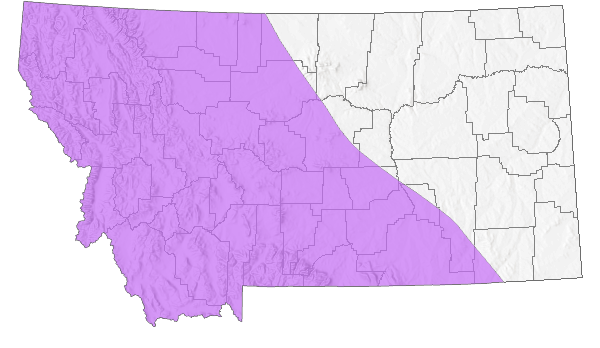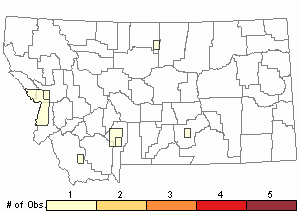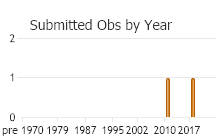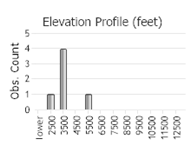View in other NatureServe Network Field Guides
NatureServe
Montana
Utah
Wyoming
Idaho
Wisconsin
British Columbia
South Carolina
Yukon
California
New York
Northern Green-striped Grasshopper - Chortophaga viridifasciata
General Description
The following is taken from Brooks (1958), Helfer (1971), Otte (1981), Capinera and Sechrist (1982), Vickery and Kevan (1985), McDaniel (1987), Pfadt (2002), Capinera et al. (2004), and Scott (2010). This species is considered a “harbinger-of-spring,” being one of the first grasshopper to appear as an adult. The body color of most females is green, whereas that of most males is brown (exceptions do occur where the gender colors can be reversed in some individuals). Females are larger than males. The wings are long, extending 2-8 mm beyond the abdomen tip. The pronotum (thorax) is raised roof-or tent-like, forming a strongly elevated carina (ridge) cut faintly by one sulcus. The top of the carina usually has a tan stripe. In dorsal view, the posterior margin of the pronotal disk is extended acutely to a point. The antennae are reddish. The basal area of the hind wing is a pale greenish yellow, merging into a smokey, faded, incomplete band. Inner face of the femur dark blue to black with two tan bands. The hind tibia can be pale brownish, dark brown, blueish-gray or reddish, with a light tan ring near the knee.
Communicative behavior/Crepitation*
Males and females crepitate loudly in flight. Most flights are short, lasting only 1 to 2 seconds, but they are strong fliers. When disturbed they take evasive flights and can cover distances up to 10-30 feet at a height of 6-24 inches. Females often fly twice those distances. When quickly disturbed, they often fly without crepitation, which will slow their speed. To human hearing, the crepitation sound is a soft buzz (Otte 1970, Vickery and Kevan 1985, Pfadt 2002).
*Crepitation is the sound produced by grasshoppers making a clicking or snapping noise with their wings when in flight, during courtship, territorial encounters or being disturbed.
Phenology
This species overwinters in the 4th to 5th instar stage with adults occurring in April (sometimes in late March) and disappearing by early July. First instar nymphs hatch by mid-July to early September. Research indicates that the species’ winter diapause is broken by lengthening daylight hours (photoperiod) rather than by temperature (Otte 1984, Vickery and Kevan 1985, Pfadt 2002, Capinera et al. 2004, Scott 2010).
Diagnostic Characteristics
The following comes from Brooks (1958), Helfer (1971), Otte (1981), Capinera and Sechrist (1982), Vickery and Kevan (1985), McDaniel (1987), Pfadt (2002), Capinera et al. (2004), Schell et al. (2005), and Scott (2010). The body length to the end of the forewings is 18-24 mm for males, and 25-30 mm for females. Femur length for males is 11-12 mm. Number of antennal segments for males 22-24, females 21-25.
Due to the Northern Green-striped Grasshopper’s colors, morphology and early spring occurrence, there should be little, if any, confusion compared to this species’ identification.
Species Range
Montana Range
Range Descriptions

 Native
Native
Range Comments
The Northern Green-striped Grasshopper is widely distributed from the East Coast (except Florida and southern Georgia) to west across the U.S. and the southern border of the Canadian Provinces to the eastern edge of British Columbia. Southward, it extends along the Rocky Mountain Front of the Western States, along the eastern edge of Mexico, well into Central America. In Montana, it has been reported for 11 counties (Otte 1984, Vickery and Kevan 1985, Pfadt 2002, Capinera et al. 2004, and Scott 2010).
Observations in Montana Natural Heritage Program Database
Number of Observations: 18
(Click on the following maps and charts to see full sized version)
Map Help and Descriptions
Relative Density

Recency



 (Observations spanning multiple months or years are excluded from time charts)
(Observations spanning multiple months or years are excluded from time charts)
Habitat
Inhabits moist, mid-grass areas. It is more abundant in the grass meadows of the eastern U.S. than in the western prairies, where its distribution is patchy due to favoring small areas which receive stream overflows or irrigation. Patches of
Western Wheatgrass (
Elymus smithii), growing in swales, around ponds and along streams are favored habitats (Pfadt 2002).
Food Habits
This species mainly consumes succulent grasses but will eat some forbs, especially sowthistle (
Sonchus sp).
Kentucky Bluegrass (
Poa pratense), is a preferred food. Others include brome,
Foxtail Barley (
Hordeum jubatum),
Western Wheatgrass (
Elymus smithii),
Quackgrass (
Elymus repens),
Little Bluestem (
Schizachyrium scoparium),
Prairie Junegrass (
Koeleria macrantha), and
Needleleaf Sedge (
Carex duriuscula) (Pfadt 2002, Capinera et al. 2004).
Reproductive Characteristics
Females are attracted to crepitating males and approach them by flying and crepitating, signaling their receptive response. The pair walk and hop toward each other, both male and female femur-tipping. The male stridulates as he approaches the female. When they touch, the male quickly mounts and copulates. The copulation last 30 to 60 minutes. The female tends to oviposit her eggs on bare, sandy-loam soils, burying the pods 1.25 inches deep. The pods are <1.25 inches long, contain 25 eggs at the bottom half inch with the remaining length hardened with froth. The eggs are light tan, 4-4.5 mm long. The eggs hatch from mid-July to August. The nymphs develop slowly, requiring about 100 days to reach the 4th or 5th instar which overwinter. There is no data regarding how many eggs this species produces in its lifetime. In Montana, this species produces one generation per year (Otte 1970, Pfadt 2002, Capinera et al. 2004).
Stewardship Responsibility
References
- Literature Cited AboveLegend:
 View Online Publication
View Online Publication Brooks, A.R. 1958. Acridoidea of Southern Alberta, Saskatchewan, and Manitoba (Orthoptera). The Canadian Entomologist (Supplement 9) 90:5-92.
Brooks, A.R. 1958. Acridoidea of Southern Alberta, Saskatchewan, and Manitoba (Orthoptera). The Canadian Entomologist (Supplement 9) 90:5-92. Capinera, J.L. and T.S. Sechrist. 1982. Grasshoppers of Colorado: Identification, Biology, and Management. Fort Collins, CO: Colorado State University Experiment Station, Bulletin 584S. 161 p.
Capinera, J.L. and T.S. Sechrist. 1982. Grasshoppers of Colorado: Identification, Biology, and Management. Fort Collins, CO: Colorado State University Experiment Station, Bulletin 584S. 161 p. Capinera, J.L., R.D. Scott, and T.J. Walker. 2004. Field Guide to Grasshoppers, Katydids, and Crickets of the United States. Ithaca, NY. Cornell University Press.
Capinera, J.L., R.D. Scott, and T.J. Walker. 2004. Field Guide to Grasshoppers, Katydids, and Crickets of the United States. Ithaca, NY. Cornell University Press. Helfer, J.R. 1971. How to Know the Grasshoppers, Crickets, Cockroaches, and Their Allies. Revised edition (out of print), Mineola, NY: Dover Publications.
Helfer, J.R. 1971. How to Know the Grasshoppers, Crickets, Cockroaches, and Their Allies. Revised edition (out of print), Mineola, NY: Dover Publications. McDaniel, B. 1987. Grasshoppers of South Dakota. Brookings, SD: South Dakota Agricultural Experiment Station, Bulletin TB 89.
McDaniel, B. 1987. Grasshoppers of South Dakota. Brookings, SD: South Dakota Agricultural Experiment Station, Bulletin TB 89. Otte, Daniel. 1970. A comparative study of communicative behavior in grasshoppers. Miscellaneous Publications, Museum of Zoology, No. 141. Ann Arbor, MI: University of Michigan.
Otte, Daniel. 1970. A comparative study of communicative behavior in grasshoppers. Miscellaneous Publications, Museum of Zoology, No. 141. Ann Arbor, MI: University of Michigan. Otte, Daniel. 1981. The North American Grasshoppers. Volume 1. Acrididae (Gomphocerinae and Acridinae). Harvard University Press. 275 pp.
Otte, Daniel. 1981. The North American Grasshoppers. Volume 1. Acrididae (Gomphocerinae and Acridinae). Harvard University Press. 275 pp. Otte, Daniel. 1984. The North American Grasshoppers Volume II. Acrididae (Oedipodinae). Harvard University Press. 366 pp.
Otte, Daniel. 1984. The North American Grasshoppers Volume II. Acrididae (Oedipodinae). Harvard University Press. 366 pp. Pfadt, R.E. 2002. Field Guide to Common Western Grasshoppers, 3rd edition. Laramie, WY: Wyoming Agricultural Experiment Station, Bulletin 912, modified by S. Schell and S. Schell for electronic publication. Accessed 19 February 2020. http://www.uwyo.edu/entomology/grasshoppers/field-guide/index.html#fieldguidetoc
Pfadt, R.E. 2002. Field Guide to Common Western Grasshoppers, 3rd edition. Laramie, WY: Wyoming Agricultural Experiment Station, Bulletin 912, modified by S. Schell and S. Schell for electronic publication. Accessed 19 February 2020. http://www.uwyo.edu/entomology/grasshoppers/field-guide/index.html#fieldguidetoc Schell, S.P., A.V. Latchininsky, and B.A. Shambaugh. 2005. Common Wyoming Pest Grasshoppers. 2nd Edition B-1161.Laramie, WY: University of Wyoming Cooperative Extension Service and Department of Renewable Resources. 76 p.
Schell, S.P., A.V. Latchininsky, and B.A. Shambaugh. 2005. Common Wyoming Pest Grasshoppers. 2nd Edition B-1161.Laramie, WY: University of Wyoming Cooperative Extension Service and Department of Renewable Resources. 76 p. Scott, R.D. 2010. Montana Grasshoppers, Katydids, and Crickets A Pictorial Field Guide to the Orthoptera. MagpieMTGraphics, Billings, MT.
Scott, R.D. 2010. Montana Grasshoppers, Katydids, and Crickets A Pictorial Field Guide to the Orthoptera. MagpieMTGraphics, Billings, MT. Vickery, V. R. and D. K. M. Kevan. 1985. The grasshopper, crickets, and related insects of Canada and adjacent regions. Biosystematics Research Institute, Ottawa, Ontario. Publication Number 1777. 918 pp.
Vickery, V. R. and D. K. M. Kevan. 1985. The grasshopper, crickets, and related insects of Canada and adjacent regions. Biosystematics Research Institute, Ottawa, Ontario. Publication Number 1777. 918 pp.
- Additional ReferencesLegend:
 View Online Publication
View Online Publication
Do you know of a citation we're missing? Anderson, N.L. 1962. Grasshopper-vegetation relationships on Montana grasslands. Ph.D Dissertation. Bozeman, Montana: Montana State University. 73 p.
Anderson, N.L. 1962. Grasshopper-vegetation relationships on Montana grasslands. Ph.D Dissertation. Bozeman, Montana: Montana State University. 73 p. Bland, R.G. 2003. The Orthoptera of Michigan—Biology, Keys, and Descriptions of Grasshoppers, Katydids, and Crickets. East Lansing, MI: Michigan State University Extension, Bulletin E-2815. 221 p.
Bland, R.G. 2003. The Orthoptera of Michigan—Biology, Keys, and Descriptions of Grasshoppers, Katydids, and Crickets. East Lansing, MI: Michigan State University Extension, Bulletin E-2815. 221 p. Cushing, W.J., R.N. Foster, K.C. Reuter, and Dave Hirsch. 1996-2000. Seasonal occurrence of common western North Dakota grasshoppers. Sydney, MT: USDA/ARS, IMP Handbook, Technical Bulletin #1809 Section VI.8.
Cushing, W.J., R.N. Foster, K.C. Reuter, and Dave Hirsch. 1996-2000. Seasonal occurrence of common western North Dakota grasshoppers. Sydney, MT: USDA/ARS, IMP Handbook, Technical Bulletin #1809 Section VI.8. De Smet-Moens, H. 1982. The insect fauna of Canada Thistle Cirsium arvense (L.) Scop in southern Montana. M.Sc. Thesis. Bozeman, MT: Montana State University. 51 p.
De Smet-Moens, H. 1982. The insect fauna of Canada Thistle Cirsium arvense (L.) Scop in southern Montana. M.Sc. Thesis. Bozeman, MT: Montana State University. 51 p. Hebard, M. 1928. The Orthoptera of Montana. Proceedings of the Academy of Natural Sciences of Philadelphia, Vol. 80:211-306.
Hebard, M. 1928. The Orthoptera of Montana. Proceedings of the Academy of Natural Sciences of Philadelphia, Vol. 80:211-306. Henry, J.E. 1969. Protozoan and viral pathogens of grasshoppers. Ph.D. Dissertation. Bozeman, MT: Montana State University. 153 p.
Henry, J.E. 1969. Protozoan and viral pathogens of grasshoppers. Ph.D. Dissertation. Bozeman, MT: Montana State University. 153 p. Kirk, K. and C.R. Bomar. 2005. Guide to the grasshoppers of Wisconsin. Madison, WI: Wisconsin Department of Natural Resources, Bureau of Integrated Science Services PUB-SS-1008. 154 p.
Kirk, K. and C.R. Bomar. 2005. Guide to the grasshoppers of Wisconsin. Madison, WI: Wisconsin Department of Natural Resources, Bureau of Integrated Science Services PUB-SS-1008. 154 p. Richman, D.B., D.C. Lightfoot, C.A. Sutherland, and D.J. Ferguson. 1993. A manual of the grasshoppers of New Mexico. Las Cruces, NM: Cooperative Extension Service, Handbook No. 7.
Richman, D.B., D.C. Lightfoot, C.A. Sutherland, and D.J. Ferguson. 1993. A manual of the grasshoppers of New Mexico. Las Cruces, NM: Cooperative Extension Service, Handbook No. 7. Sater, S. 2022. The insects of Sevenmile Creek, a pictorial guide to their diversity and ecology. Undergraduate Thesis. Helena, MT: Carroll College. 242 p.
Sater, S. 2022. The insects of Sevenmile Creek, a pictorial guide to their diversity and ecology. Undergraduate Thesis. Helena, MT: Carroll College. 242 p.
- Web Search Engines for Articles on "Northern Green-striped Grasshopper"
- Additional Sources of Information Related to "Insects"





